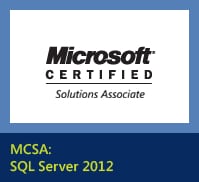- Boot Camp Format: 5 days

- Required Exam: 70-461

Overview:
Managing required information by storing and retrieving data is part of Database Administrators day-to-day activities. One of the most effective ways to manage required information is by using databases. You may need to manipulate and modify your table data based on changing business requirements. The course, Microsoft SQL Server 2012: Querying Microsoft SQL Server 2012 will help you use SQL Server 2012 as a tool to manage organizational data.
In today’s competitive environment, information plays a vital role in determining the success of an organization. If you are able to effectively manage information, you can provide a competitive edge to your organization. Familiarizing yourself with database querying concepts will enable you to effectively manage your organizational data.
In this course, you will create queries to retrieve, add, update, and maintain your database data. You will also work with data sorting, built-in functions, stored procedures, subqueries, table operators, set operators, conditional operators, views, indexes, and error handling features of SQL Server 2012.
Pre-requisite:
- Working knowledge of relational databases.
- Basic knowledge of the Microsoft Windows operating system and its core functionality.
Audience:
This course is designed for Database Administrators, Database Developers and Business Intelligence professionals. This course will be attended by report writers, business analysts, and client application developers who wish to upgrade their skills and knowledge in SQL Server 2012.
This course is also for students seeking the Microsoft Certified Solutions Associate: SQL Server certification and who want to prepare for Exam 70-461, Querying Microsoft SQL Server 2012.
Course Outline: Please download PDF[sc:pdficon ]
Need Help Signing Up For Training?
[bs_row class=”row”]
[bs_col class=”col-md-6″]
Please complete below form for help
* These fields are required.
[/bs_col]
[bs_col class=”col-md-6″]
[/bs_col]
[/bs_row]








